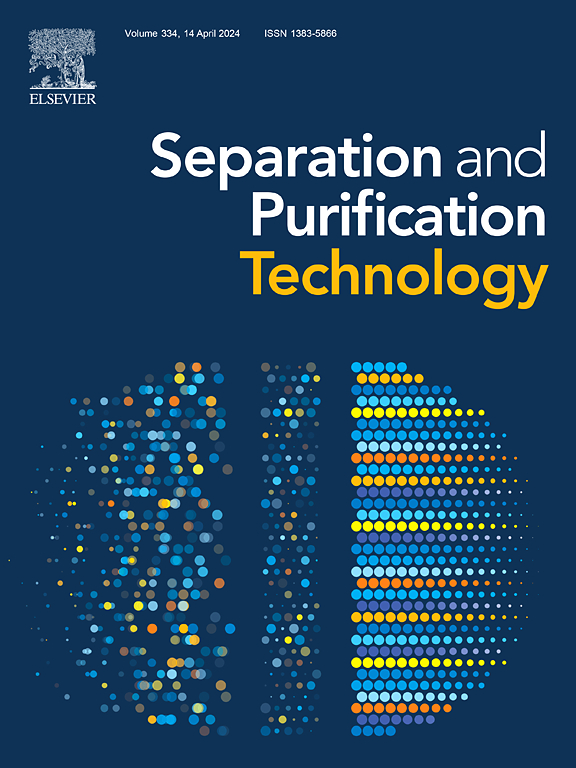CO2 adsorption and separation by fullerene encapsulated MOF: A multiscale insight combining molecular dynamics and density functional theory
IF 8.1
1区 工程技术
Q1 ENGINEERING, CHEMICAL
引用次数: 0
Abstract
Composites encapsulating fullerenes into metal–organic frameworks (MOFs) have great potential as efficient CO2 adsorption and separation materials. However, the microscopic structure–function relationship and underlying mechanisms for such materials remain unclear. By multiscale simulations combining molecular dynamics (MD) and density functional theory (DFT), we have investigated the effect of adding fullerene C60 to a typical MOF-177 on CO2 adsorption and separation from equilibrium and kinetics perspectives and explained their microscopic mechanisms. It is found that the adsorbed amount and gas adsorption energy in the low-pressure range increases with increasing C60 number, and the adsorption isotherm shifts from the Henry to the Langmuir model, not only due to the increase in surface area, but also the synergistic effect of co-adsorption of C60 with CO2. Although the addition of C60 attenuates CO2 adsorption kinetics and diffusion, the enhancement of equilibrium adsorption capacity predominates, resulting in an CO2 permeability increase of 38 % under optimal C60 incorporating numbers in the range of 5 ∼ 10 per unit cell. The adsorption selectivity of CO2/H2 can be increased by an order of magnitude when C60 is saturated. Overall, the selectivity improvement of mixtures of CO2 and lighter gases is more obvious by C60 encapsulation. Particularly, we demonstrate from a kinetic point of view that the addition of C60 achieves separation of the otherwise inseparable H2S/CO2 mixture. The competition between different adsorbed molecules dominates the change in adsorption selectivity after the addition of C60. Our results provide deep insights into CO2 adsorption and separation by MOF incorporated with carbon nanomaterials.富勒烯包封MOF吸附和分离CO2:结合分子动力学和密度泛函理论的多尺度视角
将富勒烯包封在金属有机骨架(MOFs)内的复合材料作为高效的CO2吸附和分离材料具有很大的潜力。然而,这些材料的微观结构功能关系和潜在机制尚不清楚。通过结合分子动力学和密度泛函理论的多尺度模拟,从平衡和动力学的角度研究了在典型MOF-177中加入富勒烯C60对CO2吸附和分离的影响,并解释了其微观机理。研究发现,随着C60数量的增加,低压范围内的吸附量和气体吸附能增加,吸附等温线由Henry模型向Langmuir模型转移,这不仅是由于表面积的增加,而且是由于C60与CO2共吸附的协同效应。虽然C60的加入减弱了CO2的吸附动力学和扩散,但平衡吸附能力的增强占主导地位,在最佳C60加入数量为5 ~ 10 /单位电池的范围内,CO2渗透率增加了38 %。当C60饱和时,CO2/H2的吸附选择性可提高一个数量级。综上所述,C60包封对CO2和较轻气体混合物的选择性提高更为明显。特别是,我们从动力学的角度证明,添加C60可以实现不可分离的H2S/CO2混合物的分离。C60加入后,不同吸附分子之间的竞争主导了吸附选择性的变化。我们的研究结果为MOF与碳纳米材料的吸附和分离提供了深刻的见解。
本文章由计算机程序翻译,如有差异,请以英文原文为准。
求助全文
约1分钟内获得全文
求助全文
来源期刊

Separation and Purification Technology
工程技术-工程:化工
CiteScore
14.00
自引率
12.80%
发文量
2347
审稿时长
43 days
期刊介绍:
Separation and Purification Technology is a premier journal committed to sharing innovative methods for separation and purification in chemical and environmental engineering, encompassing both homogeneous solutions and heterogeneous mixtures. Our scope includes the separation and/or purification of liquids, vapors, and gases, as well as carbon capture and separation techniques. However, it's important to note that methods solely intended for analytical purposes are not within the scope of the journal. Additionally, disciplines such as soil science, polymer science, and metallurgy fall outside the purview of Separation and Purification Technology. Join us in advancing the field of separation and purification methods for sustainable solutions in chemical and environmental engineering.
 求助内容:
求助内容: 应助结果提醒方式:
应助结果提醒方式:


